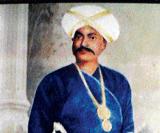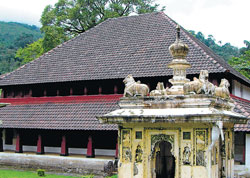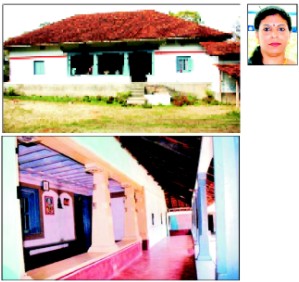Chepudira Ponnappa was one of the four dewans in the court of Chikka Veerarajendra, the last raja of Kodagu. During his later years, he was no longer the king’s favourite counsel. However, when the British marched into Madikeri, they chose to continue the services of Ponnappa and other officials, writes C P Belliappa.
Chepudira Ponnappa was one of the four dewans in the court of the last raja of Kodagu, Chikka Veerarajendra. The other three were Dewan Apparanda Bopanna, Dewan Laxminarayana and Dewan Basavanna.
Dewan Ponnappa was a colourful personality. As a teenager, he attracted the attention of Chikka Veerarajendra’s grandfather Lingaraja, when he accompanied the raja on a hunting expedition. They were camping by the side of a stream and the raja was in a relaxed mood. At a distance, a herd of buffaloes was grazing. A crow sat on the back of one of the buffaloes. Lingaraja asked if anyone could shoot the crow without hurting the buffalo. Young Ponnappa took the challenge and impressed the raja with his marksmanship. He was immediately inducted into the army and rose rapidly in the ranks.
He was appointed an army commander during the end of Dodda Veerarajendra’s reign. When Lingarajendra succeeded his brother, Ponnappa was elevated as a dewan.
Ponnappa married Cheyyavva from the Kodendera family. By 1800, they had three sons and four daughters. Ponnappa had additional responsibilities of collecting land revenue and in enforcing law and order. For this task, he had to be away from home for long periods of time. Cheyyavva, a formidable lady, took on the responsibilities of looking after their vast paddy fields during her husband’s absence. Ponnappa had built a large house in Kirgoor, and at the time it was one of the best constructions. There is an interesting story about the carpenter who built the house. The same carpenter carried out substantial work at the raja’s palace. After settling his dues, the raja gave him a paltry bonus. The carpenter supposedly commented later, “What kind of a raja is this. His official: Ponnappa tipped me with double the number of gold coins.” The raja was furious when he heard this, but by then, the carpenter had safely returned to Kerala!
During one of Ponnappa’s extended tours, he camped in a remote village for a week. He was the guest of the village headman who belonged to the Manjera family. The headman’s beautiful young daughter Somavva was serving food to the important visitor; and Ponnappa was smitten by the attractive damsel. Ponnappa, then in his 30s, mustered all his courage to ask the headman for his daughter’s hand in marriage.
Somavva’s father and Manjera family members were elated at this offer from the powerful and prosperous Ponnappa even though their daughter would be his second wife. The village elders insisted on the marriage taking place immediately, and Somavva gave her much feigned coy assent. Ponnappa extended his stay and the villagers enthusiastically started preparations for the wedding. There was excitement all round. Their new influential ‘son-in-law of the village’ was heartily felicitated.
A week later, it dawned on Ponnappa that he now had the delicate task of facing his first wife along with his new bride! As he approached his house in Kirgoor, an unsuspecting Cheyyavva came out to greet her husband who had been away for over a month. When Cheyyavva saw Ponnappa with a demure Somavva still in her bridal finery by his side, she flew into a rage. She brandished an odi katthi (sword) and stood menacingly near the entrance. Ponnappa had to retreat, and he soon undertook construction of another house, identical to the one built earlier, to start a family with Somavva. He had four sons and three daughters with Somavva.
Disillusioned dewan
By 1830, Ponnappa was disillusioned with the erratic and despotic rule of Chikka Veerarajendra. By then, he was 66 years old and distanced himself from playing an active part in the administration though he continued as a dewan. Chikka Veerarajendra listened more to the uncouth Dewan Basavanna who was his childhood companion and a kennel-keeper. Basavanna was intensely disliked by the citizens who referred to him as Kunta Basava since he had a limp.
The young raja had gone on a collision course with the British who were well-entrenched in the neighbouring areas of Karnataka and Kerala. In 1833, Chikka Veerarajendra angered the British by taking Kulpally Karunakara Menon, an emissary of the British East India Company, as hostage. Karunakara Menon warned the raja not to antagonise the British. In Menon’s famous words: “The British had the capacity to raise troops which could outnumber the trees in Kodagu! Ill advised by Dewan Basavanna, Chikka Veerarajendra remained defiant and demanded the British to hand over his brother-in-law and sister who had been given asylum in Mysore. Chikka Veerarajendra accused his brother-in-law of hatching a plot to overthrow him. By early 1834, the British decided to attack Kodagu. British troops encircled Kodagu from Mysore, Kodlipet, Kannur and Mangalore. A besieged raja called Dewan Ponnappa for advice. Dewan Ponnappa’s counsel was to immediately and unconditionally release Karunakara Menon. He was candid that the British could not be countered militarily. This enraged Dewan Basavanna who suddenly struck Dewan Ponnappa. Seventy-year-old Ponnappa momentarily lost consciousness but soon recovered. Without uttering another word, he walked out of Madikeri fort. This was a defining moment in the history of Kodagu. Dewan Bopanna and other Kodava elders were appalled and they agreed it would be better if the administration of Kodagu was taken over by the British. They decided not to resist the impending British intervention. On April 10, 1834, the East India Company under Colonel J S Fraser marched into Madikeri fort and announced the ouster of Chikka Veerarajendra. Kodagu was annexed and the raja was permanently exiled from his kingdom.
The British very diplomatically continued the services of Dewan Ponnappa, Dewan Bopanna and many other Kodava officials. Dewan Ponnappa lived to a ripe-old age of eighty-four. Before he died in 1847, his first wife Cheyyavva extracted a promise from him and her sons. Cheyyavva wanted to be buried closer to Ponnappa’s grave than her bête noire Somavva! This wish was fulfilled. The graves of Ponnappa’s two wives are located on either side of his tomb with that of Cheyyavva being closer by a foot!
His legacy
One of Ponnappa’s sons, Madayya was very influential, and in 1866, he renamed a small hamlet known as Balelesanthe (a place famous for selling banana leaves – an important commodity those days) as: Ponnappanapete after his illustrious father. Over the years, it transformed to Ponnampet and is currently a flourishing town in Kodagu. Chepudira family members installed a statue of Dewan Ponnappa in Ponnampet when the clan hosted the Kodava Hockey Festival in the town in 2000. Not to be forgotten, of course, is the fact that in 1957, Dewan Ponnappa’s great-great-granddaughter’s son, K S Thimayya, took charge as the Chief of Army Staff of India!
source: http://www.DeccanHerald.com / Home> Supplements> Spectrum / 25th, May 2012










